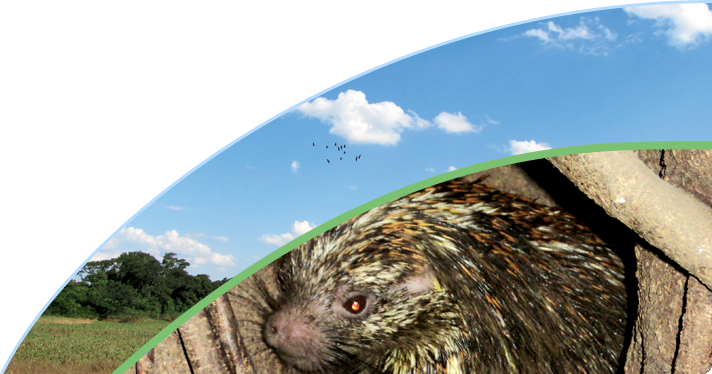preservation
Tetra Pak keeps a Permanent
Protection Area at its
Country Club (Monte Mor, SP) that is home to several species of animals:
• 149 birds such as whistling ducks, southern lapwings, and thrushes
• 14 mammals such as
edgehogs, deers,
and tamarins
Grossa plants reduced
the consumption of
materials in 2011.
grandsons of employee Sebastião Silva
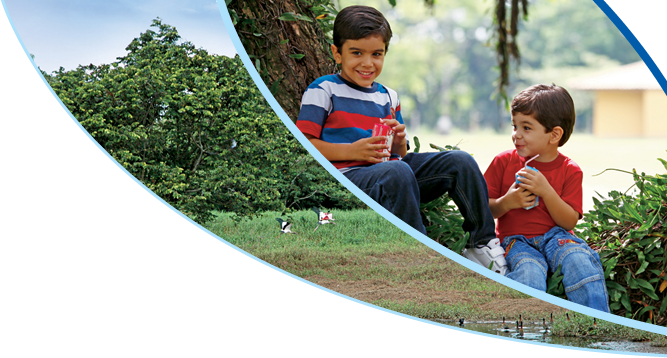
The environment is part of Tetra Pak's business. In 2010, Tetra Pak established its commitment with the environment as the fourth strategic pillar of the company. The integration of the environment to its business represented a step forward inside the corporation, training people on sustainability, thus strengthening environmental projects and programs that are cross-related between the several sectors, from the shop floor staff to top executives.
MATERIALS
| Material consumed | ||||||||
|---|---|---|---|---|---|---|---|---|
| 2011 | 2010 | 2009 | 2008 | |||||
| Monte Mor | Ponta Grossa | Monte Mor | Ponta Grossa | Monte Mor | Ponta Grossa | Monte Mor | Ponta Grossa | |
| Paper (kton) | 94 | 108 | 112 | 122 | 95 | 114 | 106 | 115 |
| Polyethylene (kton) | 22 | 24 | 23 | 25 | 21 | 23 | 24 | 24 |
| Aluminium (kton) | 6 | 8 | 6 | 8 | 5 | 8 | 5.5 | 7.5 |
| Film (kton) | 1.6 | 0 | 1.8 | 0 | 2 | 0 | 2 | 0 |
| Ink (ton) | 497 | 476 | 472 | 476 | 420 | 485 | 494 | 452 |
| Pallet (pc) | 159 | 139 | 145 | 117 | 140 | 122 | 156 | 131 |
According to regulations by the Brazilian Health Surveillance Agency (Anvisa), the use of recycled materials in the packages composition is not allowed. So, Tetra Pak tries to use the several products made from recycling the post-consumption long life packages, such as bags, business cards and envelopes, pens and other stationery. Gifts are also produced out of recycled plastic and aluminium. The paper cuvettes suppliers are encouraged by the company to use fibres from post-consumption carton packages in their production process.
Over these two years, Tetra Pak developed the edge protector made out of the polyethylene and aluminium recovered from the post-consumption packages, which is used these days by the carriers to protect the package coils during transport to the customers. This initiative prevents waste because this new edge protector can be reused (estimated durability of five years), while the previous one was disposed of after the first use.
ENERGY
• EN3 | EN4 | EN5 | EN6 | EN7 •
Total energy consumption at Tetra Pak in 2011 was 316,271 GJ, 6.48% higher if compared to the previous year. This increase results mainly from larger production (12 billion packages in 2011 against 11 billion packages produced in 2010). Even so, the ratio of energy consumption per unit was about 2% lower in 2011 compared to 2010.
The major source of energy is hydroelectric with 257,496 GJ in the past year, representing 81.42% of the consumption in 2011. Liquefied Petroleum Gas (LPG) is the second largest source with 37,387 GJ (11.82%), followed by natural gas with 21,387 GJ (6.76%) and petrol and diesel with only 1.03 GJ. Besides low consumption of petrol and diesel, we can point out the decreasing use of LPG – no-renewable source – owing to improvements in conservation and efficiency that reduced this consumption in 6.42% over two years. In addition, the company received a certificate of provenance of the hydroelectric energy consumed, proving to come from renewable sources.
Having the Environment as a pillar for its businesses, every new package or equipment developed by Tetra Pak must be better in terms of water and energy consumption than the previous versions. The "Design for Environment" concept works solely to guarantee these requirements.
| Total consumption of indirect energy GJ | 2011 | 2010 | 2009 | 2008 | |
|---|---|---|---|---|---|
| Monte Mor | 157,947 | 140,640 | 125,525 | 136,099 | |
| Ponta Grossa | 99,549 | 98,447 | 97,721 | 95,661 | |
| Subtotal | 257,496 | 239,087 | 223,246 | 231,760 | |
| Total consumption of direct energy GJ | 2011 | 2010 | 2009 | 2008 | |
| Monte Mor | LPG | 36,109 | 25,514 | 33,135 | 36,516 |
| Ponta Grossa | LPG | 1,278 | 6,273 | 6,815 | 5,665 |
| Natural gas | 21,387 | 22,110 | 19,106 | 17,488 | |
| Petrol and diesel | 1 | 46 | 69 | 56 | |
| Subtotal | 58,775 | 53,943 | 59,125 | 59,725 | |
| Total consumption of energy GJ | 2011 | 2010 | 2009 | 2008 | |
| Monte Mor | 194,056 | 170,154 | 158,660 | 172,615 | |
| Ponta Grossa | 122,215 | 126,876 | 123,711 | 118,870 | |
| Total | 316,271 | 297,030 | 282,371 | 291,485 | |
WATER
Tetra Pak invests continually in the improvement of processes and equipment, aiming at reducing the impacts of production on water consumption.
The water consumed in Ponta Grossa comes from public supply, so it is impossible to measure the impact of removing the water. Still, consumption dropped between 2010 and 2011, from 62,071 cubic meters to 50,697 cubic meters, a variation of 18.32%.
In Monte Mor, water comes from artesian wells but with no significant impact. Between 2010 and 2011 there was an increase of 14.53% in consumption, going from 71,241 cubic meters to 81,589 cubic meters.
Tetra Pak Brasil recovers water from atmospheric condensation. In 2010, 4,176 cubic meters of water were recovered from condensation, representing 5.6% of total consumption. In 2011 recovery totalled 5,357 cubic meters or 6.5% of the year consumption. In 2011 the company also started a project to reuse the water treated at its Effluents Treatment Plant in toilets, representing around 20 cubic meters reused per month. For 2012 the goal is to expand the number of places where water is reused.
EFFLUENTS
The effluents in Ponta Grossa are treated in aerobic process by activated sludge with filtration and disinfection by ultraviolet radiation and discharged into the Cará-Cará river. As for Monte Mor, the Effluents Treatment Plant uses the activated sludge method by long-lasting aeration, discharging the effluents into the local sewage system.
| Discharge of sanitary effluents per unit m3 | ||
|---|---|---|
| 2010 | 2011 | |
| Ponta Grossa | 31,365 | 18,037 |
| Monte Mor | 29,507 | 29,916 |
ENVIRONMENTAL IMPACTS
• EN26 •
Environmental efficiency is the core to Tetra Pak's strategy. The company works to increase performance by focusing on efficiency of resources, energy and waste.
Initiatives for the reduction of Tetra Pak Brasil's environmental impacts
- Carry out tests to replace the solvent by water and soap in the pre-printing process
- Reuse water in toilets and for lawn/garden irrigation
- Reduce emissions of Volatile Organic Compounds (VOCs)
by installing electrostatic filters in the laminators
- Use water-based ink
The installation of the new laminator in Monte Mor reduced in 25% the consumption of energy and in 10% the consumption of LPG
- LED lighting in the offices at Monte Mor
- Effluent Treatment Plant fitted with filtering
and disinfection equipment to improve the
quality of the water in Ponta Grossa
- Composting of organic waste from the
canteen and garden trimming in Ponta Grossa
- Installation of Voluntary Delivery Points at the Monte Mor and Ponta Grossa plants and at the Campinas office
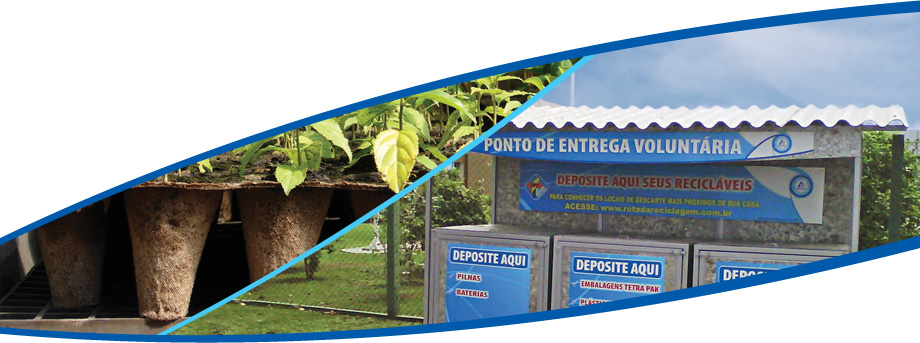
EMISSIONS
In 2011, with the installation of electrostatic filters in Ponta Grossa, the emissions rate – that were below the thresholds stipulated by law – dropped even more. Before the filters, emissions of Volatile Organic Compounds (VOCs) were 126 mg/Nm³, below the legal threshold (
The reduction of emissions of particulate materials was even bigger, 70.59%, going from 34 mg/Nm³ to 10 mg/Nm³, while the legal threshold is 250 mg/Nm³. In 2012, the company will prepare the inventory of total emissions (plant, administration and suppliers) aiming at producing a historical series.
Tetra Pak Brasil has set the goal to prepare the Greenhouse Gases Emission inventory in 2012.
Pollutants in Ponta Grossa
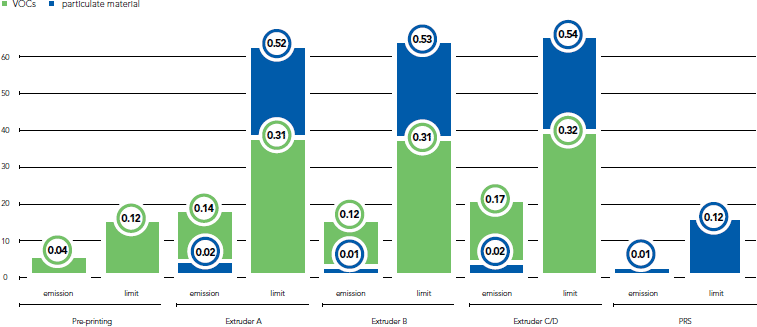
Concentration limit in Ponta Grossa mg/Nm3

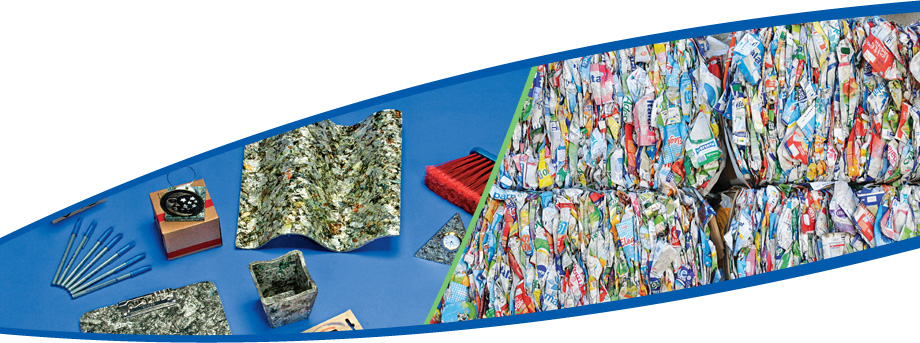
WASTE
All the company's waste that is deemed hazardous is treated in Brazil, and there is no international transport thereof. In 2011, 1,582 tons of hazardous residues were sent to recovery against 930 tons in 2010. The increase in hazardous waste sent to energy recovery in 2011 occurred because the ink ultrafiltration system was shut down in 2011, which was restarted in December this year.
| Waste disposal | |||||
|---|---|---|---|---|---|
| Type | Method | Monte Mor | Ponta Grossa | ||
| Non-hazardous waste | Weight (ton) 2010 | Weight (ton) 2011 | Weight (ton) 2010 | Weight (ton) 2011 | |
| Cardboard | Recycling | 10.682 | 10.768 | 102 | 188 |
| Plastic | Recycling | 1.045 | 1.071 | 28 | 76 |
| Iron | Recycling | 234 | 229 | 55 | 113 |
| Aluminium | Recycling | 54 | 78 | 24 | 12 |
| Wood | Recycling | 633 | 846 | 182 | 214 |
| Soy oil (litres) | Recycling | 1.680 | 1.440 | - | 1 |
| Plant sweeping/trimming | Composting | 266 | 237 | - | - |
| Trimming (lawn and trees) | Composting | - | - | 22 | 28 |
| Organic waste (canteen)* | Composting | - | - | 90 | 94 |
| Water with ink residue | Biological treatment | 1.666 | 600 | - | - |
| ETP sludge | Biological treatment | 697 | 793 | 174 | 158 |
| Total | 16.957 | 16.062 | 677 | 884 | |
| Hazardous waste | |||||
| Solvent | Recovery and reuse | 263 | 367 | 357 | 370 |
| Health service waste | Decontamination | 0 | 0 | - | - |
| Ink dross | Co-processing with energy recovery |
327 | 900 | 528 | 609 |
| Lubricant oil | Recycling | 3 | 3 | 2 | 13 |
| Bulbs (units) | Recycling | 8.000 | 8.747 | 2 | 2 |
| Photolithography | Recycling | - | - | 54 | 54 |
| Industrial towels | Recycling | 40 | 43 | 35 | 33 |
| Total | 8.633 | 10.060 | 978 | 1.081 | |
PROTECTED AREAS
As Tetra Pak is aware of the need to preserve the environment, it keeps at its Country Club in Monte Mor, in the State of São Paulo, a forest protected area that ten years ago was a region degraded by a brick factory. Today, after planting thousands of native trees it is home to hundreds of species of birds and other animals. Besides the courts, pitches, changing rooms and pools, the club counts on a Permanent Protection Area (PPA), a lake and a reforested area with native and exotic trees and plants.
A study carried out by the University of Campinas (Unicamp) in 2011 points out that the club receives 149 species of birds annually, and 12 new species are found per month on average, and there are signs that new species are still to be found. Among others, the club is home to whistling ducks, picazuro pigeons, wild ducks, cormorants, tiger herons, jabirus, little wood rails, southern lapwings and several other species of swallows, thrushes, humming-birds, herons, pigeons and hawks. Among reptiles and amphibians, toads, frogs, boidae, bothrop and helicops snakes, geckos, lizards and even a broad snouted caiman have been spotted.
Fourteen different species of wild mammals have been registered as well, such as wild dogs, jaguarondis, otters, ferrets, raccoons, capybaras, river rats, hedgehogs, opossums, armadillos, deers, hares and tamarins. Of those, the hedgehog, the opossum and the river rat live in the place. The other species registered use parts of the club as hunting territory or passage. The Capivari River and the huge number of birds that explore and nest in the area may be the reason for the presence of carnivorous animals such as the wild dog.
The presence of such a variety of species of mammals, many of which are not expected to live in a region so near Monte Mor urban area, and far from the remnants of the rainforest and savannah, emphasizes the importance of Tetra Pak's club.
